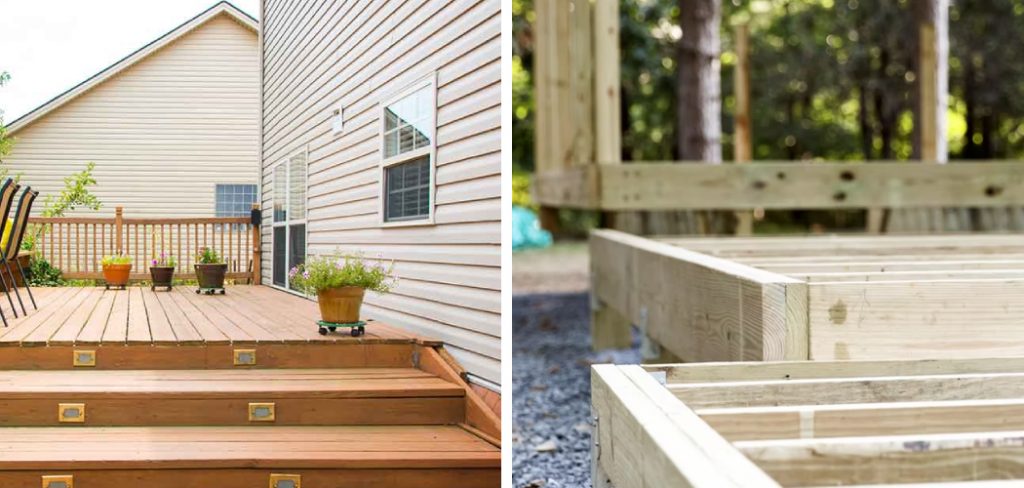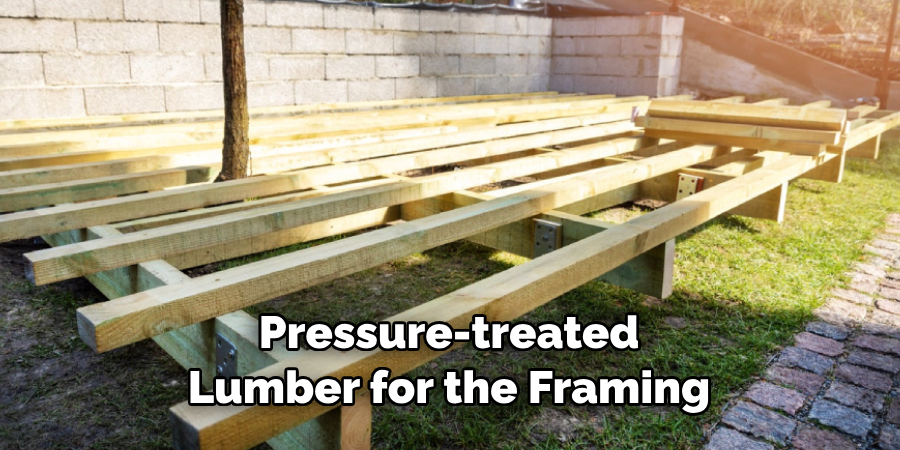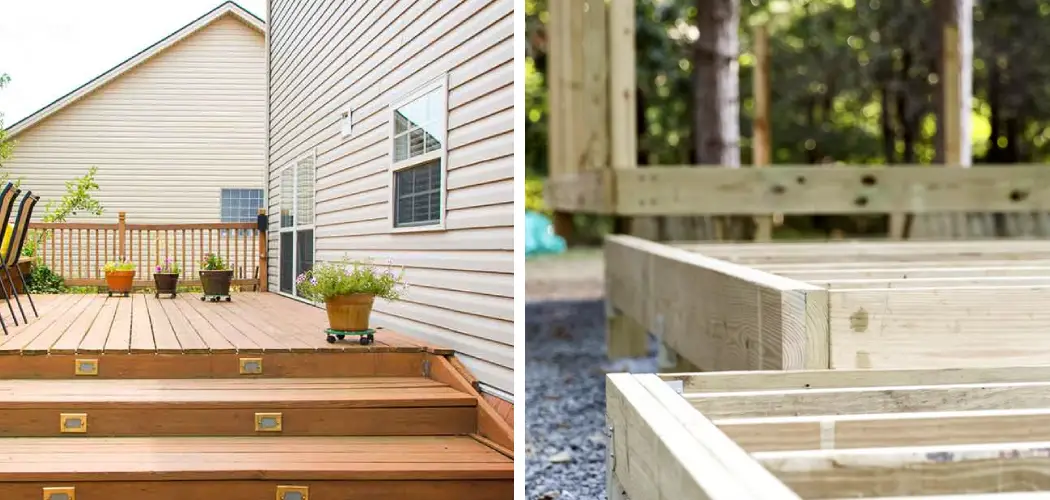Building a multi-level deck in your backyard can be an exciting and rewarding project. From the planning stage to the finishing touches, you can create a space that suits your outdoor lifestyle. Whether it’s for entertaining friends, creating a peaceful retreat, or providing extra storage and living space for family members, there’s no better way to get more out of your backyard than with a multi-level deck.

In this blog post, we’ll provide step-by-step instructions on how to build a multi level deck area. With clear guidance from our experts and some elbow grease from you, you’ll soon have the perfect multi-level deck that looks great while providing years of enjoyment!
Benefits of a Multi-Level Deck for Enhanced Outdoor Living Space
Creating a multi-level deck in your backyard can open up an entirely new world of outdoor living. A deck with more than one level can serve as an entertainment area, complete with seating and décor, for friends and family to gather around. It can also be a great way to extend the usable space of your yard, giving you more room for landscaping projects or other amenities.
In addition to providing an extended outdoor living space, multi-level decks offer several unique benefits when compared to traditional one-level decks. With a higher elevation off the ground, you’ll be able to take in better views of your entire property or surrounding areas. You can also create sections for different activities like grilling and dining on one level while relaxing and lounging on another. A multi-level deck can even provide some privacy from neighbors if desired.
The most attractive benefit of having a multi-level deck is that it creates visual appeal by breaking up large open spaces with multiple levels, stairs, and railings. This makes the space look more interesting and inviting for guests, as well as adding character to your outdoor area.
Importance of Proper Planning and Construction Techniques
Proper planning and construction techniques are essential when constructing a multi level deck. Not only will this help ensure that the deck is structurally sound, but it will also help to make sure it looks good and is safe for everyone to enjoy. To build a multi level deck, there are several factors that must be taken into consideration before beginning the project.
First, research local zoning regulations in your area regarding building a multi-level deck. These rules can vary from state to state or even city to city, so check with your local building authority before starting on any work. Additionally, consider the size and shape of your space as well as where you want the different levels of the deck situated within your yard. Make sure that you take into account any existing structures, such as trees or sheds that may affect the placement of your deck.
When creating a multi-level deck, it is important to choose quality materials and ensure that they are properly treated for outdoor use. Pressure-treated wood is highly recommended in order to help protect your deck from rot and decay over time. Additionally, be sure to select fasteners specifically designed for outdoor use, such as galvanized screws or stainless steel bolts.
Finally, make sure that all levels of the deck are properly connected using joists and ledger boards so that no movement will occur between them when people walk on it. Once all these steps have been taken care of correctly, construction can begin on your multi level deck! With the proper planning and construction techniques, you can be sure to have a stunning deck that will last for years to come.

10 Ways How to Build a Multi Level Deck
Step 1: Design and Planning:
Begin by designing your multi-level deck, considering factors such as the desired size, layout, and functionality of each level. Determine the number of levels, their heights, and how they will connect. Create a detailed plan, including measurements, materials, and necessary permits, and consult local building codes and regulations.
Step 2: Assess the Site:
Evaluate the site where you plan to build the multi-level deck. Take into account factors such as slope, sun exposure, existing structures, and landscaping. Consider any obstacles or features you want to incorporate into the design and ensure that the site is suitable for construction.
Step 3: Determine the Deck Height:
Decide on the height of each level of the deck. Consider the natural flow of your outdoor space, accessibility, and aesthetic preferences. Ensure that each level is properly elevated to create visual interest and functional separation.
Step 4: Prepare the Foundation:
Prepare the foundation for each level of the deck. This may involve clearing vegetation, leveling the ground, and creating solid footings or piers. Consult local building codes for the appropriate depth and spacing of footings and consider using concrete footings for stability.
Step 5: Frame Each Level:
Construct the frame for each level of the deck, following the design and measurements from your plan. Use pressure-treated lumber for the framing, ensuring proper spacing, support, and reinforcement. Ensure that the frames are level and square to maintain structural integrity.

Step 6: Install Posts and Beams:
Install posts and beams to support each level of the deck. Place posts at appropriate intervals, considering the load-bearing requirements. Attach beams to the posts, ensuring a secure connection. Use metal connectors or brackets to reinforce the connections and provide additional stability.
Step 7: Install Joists and Decking:
Install joists perpendicular to the beams, ensuring proper spacing for structural integrity. Attach the decking boards to the joists, using screws or nails according to the manufacturer’s instructions. Leave appropriate gaps between the boards for drainage and expansion.
Step 8: Build Stairs and Railings:
Construct stairs to connect the different levels of the deck, ensuring compliance with local building codes and safety standards. Install railings for safety, using materials that complement the overall design. Consider adding decorative elements to enhance the aesthetics.
Step 9: Add Finishing Touches:
Add finishing touches to enhance the functionality and aesthetics of the multi-level deck. This may include features such as built-in seating, lighting, pergolas, or privacy screens. Consider incorporating landscaping elements, such as planters or flower beds, to integrate the deck with the surrounding environment.
Step 10: Perform Final Inspections and Maintenance:
Conduct a thorough inspection of the completed multi-level deck, checking for any loose connections, protruding nails, or structural issues. Make any necessary adjustments or repairs. Regularly maintain the deck by cleaning it, inspecting for wear and tear, and performing any necessary maintenance tasks to ensure its longevity and safety.
Assessing the Available Space and Considering the Desired Deck Layout
Once you have decided to build a multi level deck, it is important to assess the available space that you have and consider the desired layout of your deck. This will help you determine the size and scope of your project as well as ensure that the finished product meets your expectations. Depending on the shape and size of your outdoor area, you may need to adjust your plans accordingly.
When assessing the available space, consider how much room there is for each individual level of the deck. In addition, think about how many stairs or ramps can be included in order to link each level together. If there are any challenging slopes or angles in your backyard, these should be taken into account when determining where each stair or ramp should be placed.
When considering the layout of your deck, think about how each individual level will be used. For example, if you intend on hosting large gatherings on your multi level deck, there should be plenty of room for seating and activities. If the deck is mainly for lounging or relaxing in the sun, consider adding features such as a hot tub or outdoor kitchen to create an inviting atmosphere. This will help you determine the size and type of materials that are best suited to form your desired design.

Some Common Mistakes When Building a Multilevel Deck
Building a multilevel deck can be quite challenging. However, if you are not careful, there are some common mistakes that you could make. To prevent these mistakes from occurring, here are a few tips to keep in mind when building a multilevel deck:
1. Not Accounting for Levels Correctly:
You must carefully account for the different heights of each level and make sure that they suit your needs. Measure the available space so that all levels will fit properly on the structure and make sure to leave enough room in between each level for movement or seating purposes!
2. Not Making Sure the Steps Are Safe:
It is important to ensure that every step is evenly spaced and well-lit so as not to cause any slips or falls. Make sure all steps are sturdy and secure, and if you are constructing a wooden deck, opt for non-slip materials like composite wood.

3. Not Choosing the Right Materials:
When building a multilevel deck, it is important to select the right material according to your needs. Different materials offer different levels of durability and weather resistance so make sure that you pick something that will last through the seasons!
Conclusion
Building a multi-level deck can be an exciting and rewarding project that can provide you with years of enjoyable outdoor experiences. Not only does it bring beauty to your home, but it adds value and usability to the space around you. While there are plenty of challenges involved in this project, the satisfaction of the finished product combined with potential savings over time is well worth your effort. If you’re up for the challenge, take a look at our article on how to build a multi level deck and get inspired by designs from around the world! You’ll be one step closer to bringing life to your outdoor space — don’t wait any longer, start building now!

